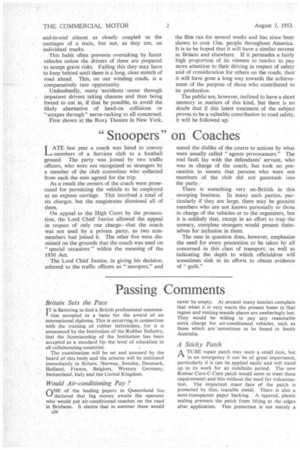Do You Drive Safely?
Page 27

Page 28

If you've noticed an error in this article please click here to report it so we can fix it.
MUCH has been said and written concerning the influence of adequate and well-designed roads on the safety of the traffic flowing over them. This influence is undoubtedly of. the greatest importance, but the fundamental factor is neither the roads nor the vehicles upon them, but the skill and state of mind of those who drive the vehicles.
Only a maniac might want an accident, yet there are many people who are either so careless or take such risks as to ask for trouble. It is, however, quite probable, and in some cases certain, that most of them do not realize where their faults lie. Few* , in fact, wOuid be prepared to admit that they are either negligent in obeying the code of road manners or driving in such a manner as to constitute a grave danger to themselves and other users of the highway.
Last week, during the introduction of a new film entitled "And Then There Were Four," which was made by the associates of the Vacuum Oil Co., Ltd. in America as a contribution .to the cause of safety on the roads and is being sponsored by the Royal Society for the Prevention of Accidents, an American concerned with its production made some observations which are of particular interest.
Shock Tactics Ineffective He pointed out that until, recently it had been thought that the best way of impressing the public and particularly drivers . with their individual responsibility to do all in their power to avoid 'road risks, was to shock them. Consequently, 'much American publicity in the way of films, signs and pictures are still of the " horrific " type, showing as staged or real indidents, the gruesome results of misjudgments or sheer recklessness.
Scenes of this nature do not, however, appear to have the effect desired. Few of those who see them can be brought to believe that they might themselves be thus involved, and that what they might consider to be a minor breach of a traffic rule could Dave r-sults so drastic.
The new method, as exemplified in this film, is to bring home to all who see it the fact that the tragedies resulting from road accidents often occur to those who may be classed _-as " ordinary " people and not merely to the daredevil or those conspicuously reckless.
To achieve this the audience is taken for a ,day into the homes of five ordinary families, one member of each, being a driver who uses a motor vehicle on the roads for a different purpose and in a different way than do the others. One sees the five set out from their • homes in the morning, whilst in the evening, in each home, the radio tells of a fatal accident--and only four return.
The four are all late and the members of the audience cannot help sharing the suspense of those who are waiting arid worrying.
Effect on Audience In one audience, which was referred to as "hard boiled" because of the familiarity of its members with matters concerning the road, there were many comments as to the intense impression created. It remains to be seen how lasting this may be, both on those and others who will share in the experience.
Some people whO are not well acquainted with the transport regulations in the United States will, no doubt, be surprised to learn that there it is an offence to drive what is considered to be too' closely behind another vehicle. This seems to' indicate that the legislators there are more aWare of the difficulties and dangers resulting from that pernicious practice, which is referred to in Britain as driving in convoy" It is regrettable to observe that coaches are particular offenders in this respect, although in most other ways there can be little complaint regarding the manner in which they are controlled.
It is understandable that where there is a large party filling a number of vehicles, there is some excuse for the coaches concerned to remain reasonably close together, especially if some of' the drivers are not fully cognizant with the route and might, if far separated, stray from it. This is no excuse, however, for running these large vehicles end-to-end almost as closely coupled as the carriages of a train, but not, as they are, on individual tracks.
This habit often prevents overtaking by faster vehicles unless the drivers of these are prepared to accept grave risks. Failing this they may have to keep behind until there is a long, clear stretch of road ahead. This, on our winding roads, is a comparatively rare opportunity.
Undoubtedly, many accidents occur through impatient drivers taking chances and then being forced to cut in, if that be possible, to avoid the likely alternative of heaci-on collisions or "scrapes through" nerve-racking to all concerned.
First shown at the Roxy Theatre in New York, the film ran for several weeks and has since been shown to over 13m. people throughout America. It is to be hoped that it will have a similar success in Britain and elsewhere. If it persuades a fairly high proportion of its viewers to resolve to pay more attention to their driving in respect of safety and of consideration for others on the roads, then' it will have gone a long way towards the achievement of the purpose of those who contributed to its production.
The public are, however, inclined to have a short memory in matters of this kind, but there is no doubt that if this latest treatment of the subject proves to be a valuable contribution to road safety, it will be followed up.
























































































